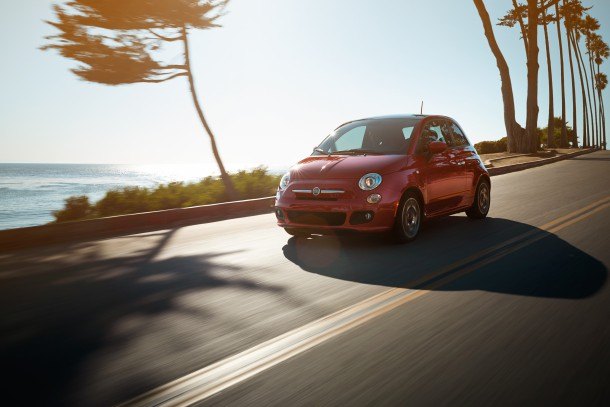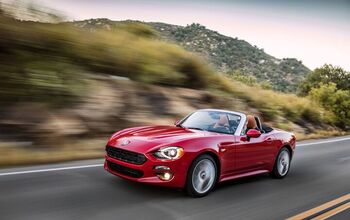Fiat Sales Are Crumbling In America
New product is not fueling renewed American interest in Fiat Chrysler Automobiles’ namesake Fiat brand.
The 500X, the latest product added to Fiat’s U.S. lineup, was clearly the brand’s best-selling model in November 2015, but sales at the brand slipped three percent, a modest drop of 82 units. Rewind one year and Fiat’s lineup featured only two nameplates: the 500 with which the brand relaunched in 2011, and the 30-month-old 500L. Adding the 500X, a true subcompact crossover, brought in 1,833 buyers in November 2015.
But the 500 and 500L combined to generate 1,915 fewer sales in November 2015 than in November 2014, astounding losses for a brand which in November of last year suffered a twelve-month sales low.
The Fiat brand’s figures in November 2015 were worse.
As the U.S. auto industry reported a 1-percent overall increase and a 10-percent increase in the daily selling rate (November 2015’s auto sales calendar was two days shorter than November 2014’s), Fiat sales decreased to the lowest level since January 2013 — prior to the 500L and 500X launches. True, the Fiat brand’s daily selling rate in November 2015 was up 6 percent, but the brand’s 0.23-percent market share was lower even than the 0.24-percent result achieved back in January 2013.
The 500L’s inability to succeed prior to the 500X’s launch only served to suggest that the 500L would tank following the 500X’s arrival. Only in August of last year, when a stop-sale order slowed the 500L to just 33 units, have 500L sales been slower than they were in November 2015. Only 228 500Ls were sold last month, FCA says, an 80 percent, year-over-year decline. This low-water mark wasn’t for want of inventory. Automotive News says that Fiat dealers had 225 days of 500L supply at the beginning of November.
The 500’s 51-percent drop to only 968 sales in November 2015 represented the first time since April 2011 – the 500’s first full month of U.S. availability – that 500 sales fell below 1,000 units. Not since October of last year have 500 sales increased on a year-over-year basis in the United States. That’s not to suggest that 2014 was kind to the 500. After sales of this core Fiat slid 18 percent in 2013, year-over-year volume slid 6 percent in 2014.
Through the first 11 months of 2015, Fiat 500 sales are down by a quarter, a loss of 7,823 sales in Fiat showrooms. The 500 is currently America’s 136th-best-selling vehicle, down 18 positions compared with this stage of 2014. As is the case with the 500L, there’s an abundant supply of 500s in the United States. Cars.com’s inventory listings currently display more than 5,000.
The 500X has certainly presented Fiat dealers with a viable alternative. This fraternal twin of the Jeep Renegade produced steadily increasing sales heading into November – from 324 in June to 2,178 in October – before slipping slightly in November, a lower-volume month for the industry overall. With 1,833 November sales, the 500X trailed the Nissan Juke (and a handful of other subcompact crossovers) but easily outsold the Mazda CX-3 and Mini Countryman.
In the FCA U.S. empire, Fiat is an increasingly inconsequential element. Only 2.6 percent of the new vehicles sold by Fiat Chrysler in the United States in 2012 were Fiats, but that figure has fallen to 1.9 percent in 2015’s first 11 months; just 1.7 percent in November. Sixteen different FCA nameplates outsell the whole Fiat brand in America, from every Jeep – including the Renegade – to every Chrysler and every Dodge except the Viper.
Though initially a hot seller, the 500 wasn’t a brand new design by the time North Americans were permitted to buy the car. Never has the 500L been anything other than ignored, a situation only worsened by dreadful reliability ratings and the 500X’s launch. The 500X, meanwhile, is the curvaceously cute Italian crossover in a category topped by its own boxy, off-roadable American twin, the Renegade. And will the 124 Spider, a Mazda MX-5 Miata platform partner, be a car that can generate meaningful volume for the Fiat brand?
Not a chance.
Timothy Cain is the founder of GoodCarBadCar.net, which obsesses over the free and frequent publication of U.S. and Canadian auto sales figures. Follow on Twitter @goodcarbadcar and on Facebook.
More by Timothy Cain
Latest Car Reviews
Read moreLatest Product Reviews
Read moreRecent Comments
- 3SpeedAutomatic 2012 Ford Escape V6 FWD at 147k miles:Just went thru a heavy maintenance cycle: full brake job with rotors and drums, replace top & bottom radiator hoses, radiator flush, transmission flush, replace valve cover gaskets (still leaks oil, but not as bad as before), & fan belt. Also, #4 fuel injector locked up. About $4.5k spread over 19 months. Sole means of transportation, so don't mind spending the money for reliability. Was going to replace prior to the above maintenance cycle, but COVID screwed up the market ( $4k markup over sticker including $400 for nitrogen in the tires), so bit the bullet. Now serious about replacing, but waiting for used and/or new car prices to fall a bit more. Have my eye on a particular SUV. Last I checked, had a $2.5k discount with great interest rate (better than my CU) for financing. Will keep on driving Escape as long as A/C works. 🚗🚗🚗
- Rna65689660 For such a flat surface, why not get smoke tint, Rtint or Rvynil. Starts at $8. I used to use a company called Lamin-x, but I think they are gone. Has held up great.
- Cprescott A cheaper golf cart will not make me more inclined to screw up my life. I can go 500 plus miles on a tank of gas with my 2016 ICE car that is paid off. I get two weeks out of a tank that takes from start to finish less than 10 minutes to refill. At no point with golf cart technology as we know it can they match what my ICE vehicle can do. Hell no. Absolutely never.
- Cprescott People do silly things to their cars.
- Jeff This is a step in the right direction with the Murano gaining a 9 speed automatic. Nissan could go a little further and offer a compact pickup and offer hybrids. VoGhost--Nissan has laid out a new plan to electrify 16 of the 30 vehicles it produces by 2026, with the rest using internal combustion instead. For those of us in North America, the company says it plans to release seven new vehicles in the US and Canada, although it’s not clear how many of those will be some type of EV.Nissan says the US is getting “e-POWER and plug-in hybrid models” — each of those uses a mix of electricity and fuel for power. At the moment, the only all-electric EVs Nissan is producing are the Ariya SUV and the perhaps endangered (or maybe not) Leaf.In 2021, Nissan said it would make 23 electrified vehicles by 2030, and that 15 of those would be fully electric, rather than some form of hybrid vehicle. It’s hard to say if any of this is a step forward from that plan, because yes, 16 is bigger than 15, but Nissan doesn’t explicitly say how many of those 16 are all-battery, or indeed if any of them are. https://www.theverge.com/2024/3/25/24111963/nissan-ev-plan-2026-solid-state-batteries




































Comments
Join the conversation
I wonder how many of their sales are to rental fleets. The first Fiat 500L I saw in person was one a coworker got from Enterprise while his was being fixed from an accident. And they had originally tried to give him a regular 500, but he complained it was too small. Having a lifestyle/image brand with a lot of fleet sales seems like an awful idea. It makes them seem cheap, plus it means a bunch of used ones on the market cannibalizing sales from new ones.
brdmawx http://www.unionfotocenter.it/144-timberland-giallone.html http://www.firenzerestauro.it/nike-free-run-2-red-gold-378.php http://www.tiratardipub.it/new-balance-580-re-engineered-185.html http://www.dsette.it/mizuno-wave-enigma-5-999.php http://www.bottega-del-legno.it/111-golden-goose-scarpe-outlet.htm Air Jordan Flight 2016 Nike Free Run Rn New Balance Grigie E Gialle Scarpe Louboutin Prezzi Uomo Prezzo Scarpe Adidas Original